Conservation of endangered plants
Conservation Efforts at the Tsukuba Botanical Garden
Conservation of endangered plants
The Tsukuba Botanical Garden is making dedicated efforts to conserve numerous endangered plants. Especially, we are focusing on plant taxa (e.g., ferns and orchids) environments (e.g., aquatic) and regions (e.g., the Ryukyus of Japan) that contain many endangered species.
Ferns
Ferns are seedless vascular plants that propagate through spores. Ferns have been known to exist for about 420 million years, since the Paleozoic Era, and currently, about 10,000 fern species exist on the earth. Approximately 850 species of ferns from eastern Asia to the South Pacific region are grown at the Tsukuba Botanical Garden for research and conservation. The outdoor fern garden features a theme-based display of ferns.
Endangered fern species are mainly grown in Nurseries that is not open to the public. As of January 2009, 77 (39%) of the 197 species of ferns put on the endangered list (2007 edition) by the former Environment Agency (currently reconstituted as Japanese Ministry of the Environment) were being grown here. Of these, five plants belonging to 3 lineages of Dryopteris shibipedis, which was treated as an extinct (EX) species, are being preserved here.
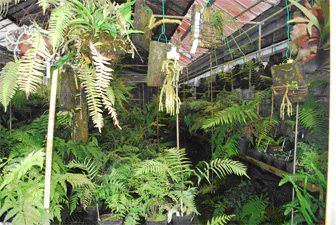 Greenhouse for fern cultivation in Nurseries, that is not open to the public
Greenhouse for fern cultivation in Nurseries, that is not open to the public
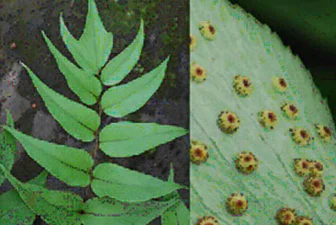 Cyrtomium macrophyllum var. microindusium (CR)
Cyrtomium macrophyllum var. microindusium (CR)
 Dryopteris shibipedis (EW)
Dryopteris shibipedis (EW)
Orchidaceae
Orchid (Orchidaceae) is the largest plant family, comprising approximately 25,000 species. Tsukuba Botanical Garden maintains one of the world's largest collections of orchids with approximately 3,000 species for research and conservation. We are propagating
endangered species by in vitro seed propagation. On the occasions of annual orchid exhibitions in our facilities, we present educational displays on sciences and arts related to orchids
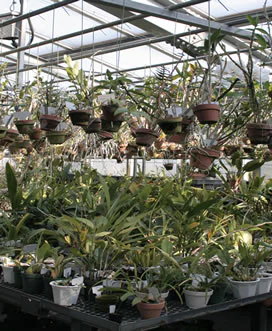
We simulate various environments in the backyard and grow many species for insurance and founders of reintroductions.
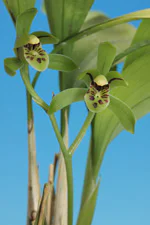
This is an endangered orchid species found in southwestern Japan. It has been recognized as synonymous withCymbidium lancifolium. However, we found that they are different species.
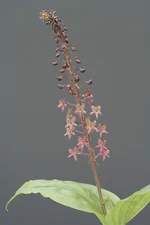
A new species discovered during field surveys conducted by Tsukuba Botanical Garden in the Republic of Vanuatu.
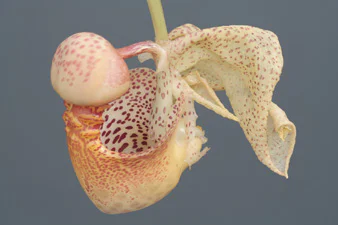
Flowers have evolved in many ways in order to attract animals that will carry pollen from one flower to another.Coryanthes macranthais one example of flowers that have undergone unique adaptations.
Aquatic plants
Approximately 160 species of around 40 families of aquatic plants, including 121 of about 222 Japanese species, are cultivated and conserved at the Tsukuba Botanical Garden.
Aquatic environment is one of the areas where natural habitats are rapidly undergoing destruction both in Japan and overseas. Approximately 41% of all aquatic plants in Japan are faced with the threat of extinction. 49% of these endangered plants are being conserved at the Tsukuba Botanical Garden. One characteristic feature of the Garden's efforts towards preservation of aquatic plants is the creation of growth environments suitable for all aquatic plants from freshwater to brackish and salt water.
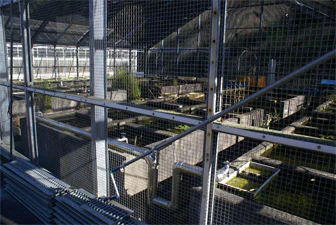 Preservation facility of aquatic plants in the nursery
Preservation facility of aquatic plants in the nursery
 Monochoria korsakowii(NT)
Monochoria korsakowii(NT)
It grows in brackish water areas. Since aquatic plants in brackish water areas are few in number, their extinction would have a significant impact on the ecosystem.
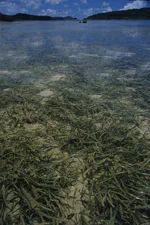
They grow in tropical seas. Many marine aquatic plants are endangered species.

An aquatic plant that has disappeared from the wild. We are conducting conservation research aimed at reintroducing it into its last natural habitat, Lake Sunanuma in Ibaraki Prefecture.

An aquatic plants that pollinate on the water surface. Detailed observation of specimens cultivated at the botanical garden revealed the mechanism of pollination.
Plants in the Ryukyus
The Ryukyu Archipelago (the Ryukyus) consists of about 200 islands spanning an area 1,300 km between Japanese Kyushu and Taiwan. The Ryukyus is known to be an area having high plant diversity and endemism, where threatened plant species can be found.
In the Garden, we are performing biodiversity studies – including of evolutional biology, taxonomy, and phylogenetics – using molecular, cytogenetic, and morphological data for biological characterization of Ryukyus plant species, especially threatened
species.
 Oxalis amamiana, endemic to Amami Island
(CR)
Oxalis amamiana, endemic to Amami Island
(CR)
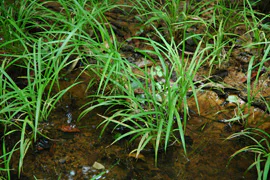 Eriachne armittii, endemic to Iriomote Island
(VU)
Eriachne armittii, endemic to Iriomote Island
(VU)
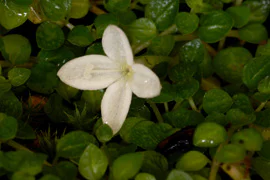 Ophiorrhiza yamashitae, endemic to Amami Island (CR)
Ophiorrhiza yamashitae, endemic to Amami Island (CR)
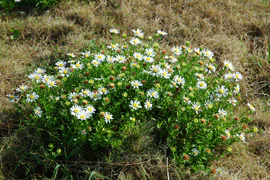 Aster asa-grayi, endemic to Amami and Okinawa islands(EN)
Aster asa-grayi, endemic to Amami and Okinawa islands(EN)
 Shortia rotundifoliadistributing in the Ryukyus and Taiwan (NT)
Shortia rotundifoliadistributing in the Ryukyus and Taiwan (NT)
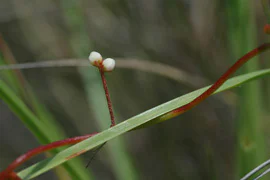 Cassytha pergracilis, endemic to Okinawa Islands (CR)
Cassytha pergracilis, endemic to Okinawa Islands (CR)
The center for preservation activities
As the Center for Preservation Activities
The Tsukuba Botanical Garden is proud to play a central role in the following networks for the preservation of diversity.
National Network of Botanical Garden for the Conservation of Plant Diversity
Tsukuba Botanical Garden has contributed to the National Network of Botanical Gardens for the Conservation of Plant Diversity organized by the Japan Association of Botanical Gardens. Under this framework, botanical gardens throughout the country and external partners cooperate to promote conservation programs while utilizing each garden's features of climates, regions, and specialties.

Water Japanese Aquatic Plant Conservatin Network
The Japan Aquatic Plants Conservation Network was founded in 2007. Its mission is to promote the efficient and effective preservation of threatened Japanese aquatic plants ex situ, and to put these vital resources to effective use in research, education and the restoration of the natural environment. From this Network's inception, the Tsukuba Botanical Garden has played a mainstay role in its operations, aiming to serve as a central facility in the preservation of Japanese aquatic plants.
-If you are involved in aquatic plant conservation, please share your information.-
The Aquatic Plant Conservation Network is seeking information about individuals, schools, and NPOs engaged in aquatic plant conservation activities.
Aquatic Plants Network Secretariat Norio Tanaka
Water Japanese Aquatic Plant Conservatin Network website, please see here. www.bgtym.org/aquatic-plant
For inquiries, please contact us here. aquatic-plant@kahaku.go.jp
outreach
The Tsukuba Botanical Garden presents various exhibits to convey the issues surrounding endangered plants and the importance of biodiversity.
Human and Biodiversity Area
The Tsukuba Botanical Garden opened a new section, the “Human and Biodiversity Area,” in fiscal year 2008. This Area raises public awareness about the importance of biodiversity while also displaying some of the endangered plants cultivated here for conservation purposes.

